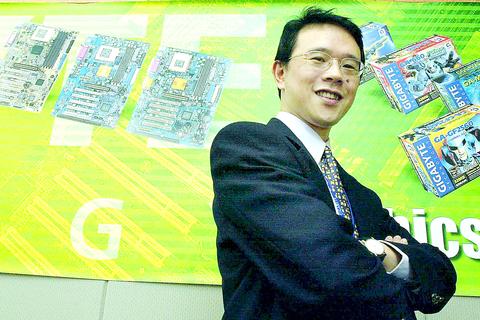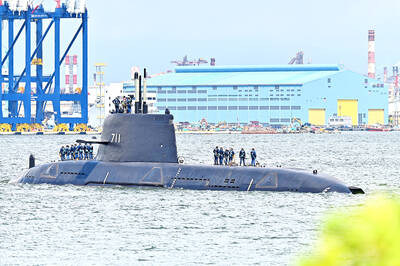Taipei Times: How important is Computex to your business? Is this prime time for motherboard orders?
Benson Chang (張文忠): I think Computex is very important. CeBit is the European event, but in the US, everyone goes to Comdex. Computex is the main show for Asia.

PHOTO: CHIANG YING-YING, TAIPEI TIMES
This year Computex is even more important because three months ago at CeBit, the market was very slow and people did not discuss a lot of the new products. So this year at Computex, there will be many new products and people expect the market to improve.
TT: This has been a tough year for IT in general, how has Gigabyte (
Chang: This year has been very tough, especially since March. Business has been going down month to month, so we are a little bit worried. Right now, it's already the worst time frame. We already see demand going back up again and we expect demand to surge in the June time frame.
TT: What will drive demand?
Chang: Since the economy is slow right now, demand is poor. But people expect the economy to come back, so that will help. New products will also help. In the Q3 time frame, Intel's Pentium IV will drive the market. They are being very aggressive with price to get it into the market and the Pentium IV's share has been getting bigger, almost triple or four times what it was a month ago.
Our response to the downturn has been to diversify our product lines. We don't want to just stay with PCs or motherboards, so we want to develop servers and other products, and I think in the second half we will have a communication's team formed.
Communication is a little bit different from our current product lines, so we have been carefully building a team to develop this business. We're looking at ADSL products and wireless solutions for computer peripherals, like wireless keyboards. It's very important for us to get wireless capability into our motherboards and other products.
You see, with the PC market growing at a slower rate, the profit for motherboards, even branded products is already down to 20 percent. In servers and other products, we can maintain a better price margin. That's why we need to diversify.
TT: Analysts say Taiwan's motherboard industry is consolidating. What's happening with Gigabyte?
Chang: The market is in consolidation, with only four big players left on top. There used to be about 40 motherboard makers, but right now there are about 15. The top four probably occupy around 60 percent of the market. Our guess is the market will be cut down to 10 companies this year. After that, only the top 5 companies will have a chance to grow.
The ODM business is another opportunity for Taiwan.
Two years ago, we entered into the ODM business and have been very aggressive to improve our designs. Now, the top ten computer makers, like Compaq and Dell, will work with companies like Gigabyte, Asustek (
TT: How will industry consolidation be played out?
Chang: Actually, the big companies are getting bigger. The smaller companies cannot compete with the top tier, especially in the current over-supply market situation. We have more bargaining power in terms of purchasing and we have a wider market share, wider customer base and we already have good branding in the channel. The writing is on the wall.
I would rather focus on how Gigabyte will grow. We want to be one of the top three motherboard makers worldwide, but right now we are only in the top five. We want to be number two.
To move up in the industry, we have to enhance our channel awareness. We have always been number two to Asustek in the channel.
The ODM business is another area we need to work on. In the past, we were not very aggressive, but there is big room for growth in the ODM business.
We need to be better with our designs in order to grow bigger. If we have economies of scale, we'll have more bargaining power and will be able to lower [the costs of components].
We also plan to continue moving production to China, costs are much lower there.
TT: How important is China to the future of Gigabyte?
Chang: It's very important. Actually, everyone is looking toward the China market. We have a factory in Dongguan and we are looking to build another one in a town near Shanghai.
We also see room to grow in China. It's a very big market. We have put a lot of resources over there, including manufacturing lines -- costs in China are only about one-third of those in our Taiwan manufacturing facilities.
TT: Do you still have motherboard plants in Taiwan or are they all in China?
Chang: Right now, only about one-third of our output comes from China, the rest is in Taiwan. But in the future we will try to make that about 50-50.
That is the major way we will lower the cost of our products -- going to China.
TT: Will you move all of your motherboard production to China?
Chang: If we move all our production over there, that would probably be dangerous. We will try to keep 50-50, going down to 30 percent in Taiwan and 70 percent in China. But we will not go to 100 percent in China.
We also have system assembly lines and server production lines in Taiwan, but we are trying to move them to China as well. Also, we will probably move our worldwide technical support center to China, they are more cost competitive over there.
TT: Most people know Gigabyte as one of Taiwan's top motherboard makers. What other products does the firm specialize in?
Chang: Actually, we have already diversified our product lines to servers, systems and VGA cards. Complete servers and server boards, and rackmount server and appliance servers -- all entry level products.
The share of our motherboard business is down to around 85 percent of company revenues and VGA graphic cards is around 5 to 10 percent of revenues.
We expect the revenue for servers will rise to 5 percent by the end of the year.
We market all of our products under the Gigabyte brand name. Our brand does quite well in the channel, I think we are almost as well known as Asustek in the motherboard market. Worldwide we have a lot of brand awareness.
TT: What surprises do you have in store for Computex?
Chang: Computex is a very exciting show. A lot of new products will be launched, including Brookdale (A45), Intel's Pentium IV chipset for SDRAM (memory chips). We will launch motherboard products for that chipset.
TT: Will the new motherboards be able to hold the whole family of Pentium IV chips, including the new 1.7 Gigahertz microprocessor?
Chang: They can support up to 2 GHz and higher with no trouble. We can support up to 2 GHz with no problem.
We will also demonstrate a port of Intel's Brookdale A45, a chipset for the new 470AP processor.
This is a very early release. Since we partnered with Intel early on in the development of that product, we will be able to demonstrate it [at Computex].
TT: What other products will Gigabyte show? Will you offer any new DDR compatible products?
Chang: Another line of products is motherboards for Tualatin, Intel's new Pentium III processor -- we have motherboards ready for that as well. The new Tualatin line of Pentium III's will support up to 1.1 GHz, and even 1.2 GHz or 1.3 GHz. Current [models] are made with a 0.18 micron process and the new one with 0.13 micron process. That's the difference between current Pentium III's and the new Tualatin line.
For the Tualatin line of Pentium III chips, we made a new colored socket for a universal socket and this is new. Intel will probably launch the processor in the June time frame, possibly at Computex and our motherboards are already in full production.
The Pentium IV will probably launch in the August-September time frame. We're already ready for those as well, it just depends on Intel's launch time frame. We have to align with them.
I think this new product is unique to Gigabyte. In the ODM motherboard business, the socket is always white. This is probably the first colored socket in the world. We did this because the new (Tualatin) Pentium III will not plug into the old Pentium III motherboards. So we made the color different so people would be able to readily identify it.
Another motherboard product we have is a DDR [double data rate memory] motherboard product, but we launched that at Comdex last November. It will work with 266 MHz DDR (memory chips). We launched the product with AMD (Advanced Micro Devices).
Actually, Gigabyte was probably the first company worldwide to launch a DDR motherboard.
At Comdex, we only launched motherboards to work with AMD's chipsets. At Computex, we will launch models for Intel chipsets and models for the third party chipset makers, Acer Labs (ALi), VIA and SIS (Silicon Integrated Systems). These are for Pentium III and (AMD's) K7 line of microprocessors.
Another focus will be on AMD's new line of Athlon processors, with the new 133 front side bus. We will have products available to support all of these new products.
TT: Will you be doing anything with graphic chipsets?
Chang: Yes, our fourth focus at Computex is Nvidia, the number one graphics chip designer. Nvidia wants to enter the core logic chipset business. At this show, they will have a very high impact press conference to launch their core logic chipset. The company has four or five partners for this product in Taiwan, including Gigabyte, Micro-Star, Asustek and Mitac.
We will demonstrate motherboards for both desktops and notebooks for Nvidia's core logic chipsets. The Nvidia chipset will probably have a heavy impact on the market, because Nvidia is number one in graphic chips.
Most of the low-end computer makers have already migrated [their PCs] to integrated graphics/core logic chipset motherboards since they are cheaper. Nvidia will be very aggressive in promoting their new chipsets.

LONG FLIGHT: The jets would be flown by US pilots, with Taiwanese copilots in the two-seat F-16D variant to help familiarize them with the aircraft, the source said The US is expected to fly 10 Lockheed Martin F-16C/D Block 70/72 jets to Taiwan over the coming months to fulfill a long-awaited order of 66 aircraft, a defense official said yesterday. Word that the first batch of the jets would be delivered soon was welcome news to Taiwan, which has become concerned about delays in the delivery of US arms amid rising military tensions with China. Speaking on condition of anonymity, the official said the initial tranche of the nation’s F-16s are rolling off assembly lines in the US and would be flown under their own power to Taiwan by way

OBJECTS AT SEA: Satellites with synthetic-aperture radar could aid in the detection of small Chinese boats attempting to illegally enter Taiwan, the space agency head said Taiwan aims to send the nation’s first low Earth orbit (LEO) satellite into space in 2027, while the first Formosat-8 and Formosat-9 spacecraft are to be launched in October and 2028 respectively, the National Science and Technology Council said yesterday. The council laid out its space development plan in a report reviewed by members of the legislature’s Education and Culture Committee. Six LEO satellites would be produced in the initial phase, with the first one, the B5G-1A, scheduled to be launched in 2027, the council said in the report. Regarding the second satellite, the B5G-1B, the government plans to work with private contractors

‘NARWHAL’: The indigenous submarine completed its harbor acceptance test recently and is now under heavy guard as it undergoes tests in open waters, a source said The Hai Kun (海鯤), the nation’s first indigenous defense submarine, yesterday began sea trials, sailing out of the Port of Kaohsiung, a military source said. Also known as the “Narwhal,” the vessel departed from CSBC Corp, Taiwan’s (台灣國際造船) shipyard at about 8am, where it had been docked. More than 10 technicians and military personnel were on deck, with several others standing atop the sail. After recently completing its harbor acceptance test, the vessel has started a series of sea-based trials, including tests of its propulsion and navigational systems, while partially surfaced, the source said. The Hai Kun underwent tests in the port from

MISSION: The Indo-Pacific region is ‘the priority theater,’ where the task of deterrence extends across the entire region, including Taiwan, the US Pacific Fleet commander said The US Navy’s “mission of deterrence” in the Indo-Pacific theater applies to Taiwan, Pacific Fleet Commander Admiral Stephen Koehler told the South China Sea Conference on Tuesday. The conference, organized by the Center for Strategic and International Studies (CSIS), is an international platform for senior officials and experts from countries with security interests in the region. “The Pacific Fleet’s mission is to deter aggression across the Western Pacific, together with our allies and partners, and to prevail in combat if necessary, Koehler said in the event’s keynote speech. “That mission of deterrence applies regionwide — including the South China Sea and Taiwan,” he